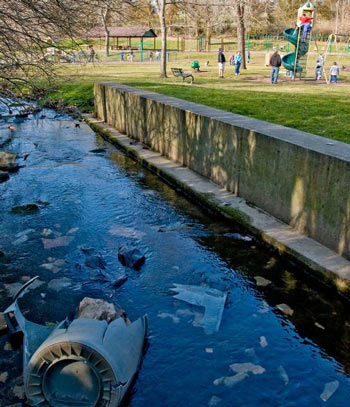CADDIS Volume 2: Sources, Stressors & Responses

Riparian/channel alteration
Intact riparian zones, or vegetated areas adjacent to stream channels, can serve several functions (Allan 1995), including:
- Provide organic matter for stream food webs
- Provide habitat (e.g., woody debris, bank vegetation)
- Reduce bank and channel erosion
- Moderate stream temperatures
- Intercept and process groundwater nutrients and pollutants
Urbanization typically reduces the extent and quality of riparian areas, via the removal of native vegetation and the development of near-stream areas (Fig 4). These alterations can contribute to multiple instream stressors, including:
Water/sediment quality: ↓ nutrient uptake and retention, ↑ erosion of bank sediments (and associated contaminants)
Temperature: ↓ shading and thermal buffering
Hydrology: ↓ woody debris inputs, ↓ interception of surface and groundwater flows
Physical habitat: ↑ erosion of bank sediments, ↓ woody debris inputs
Energy sources: ↓ leaf inputs, ↑ algal biomass (due to ↓ shading), ↑ dissolved organic carbon

Photo by Bob Davis, courtesy of NOAA
Direct modification of stream channels is common in urban systems, and these direct alterations of channel morphology often are the most damaging changes urban streams experience (see the Physical Habitat module, as well as the Physical Habitat section of this module).
Typical channel alterations in urban streams include:
- Channelization (i.e., channel straightening)
- Channel hardening or armoring (e.g., lining channels and banks with concrete and riprap)
- Creation of dams and impoundments
- Stream piping and burial
Click below for more information on specific topics




Courtesy of U.S. EPA.

From Pennington DN et al. 2008. The conservation value of urban riparian areas for landbirds during spring migration: land cover, scale, and vegetation effects. Biological Conservation 141:1235-1248. Reprinted with permission from Elsevier.
